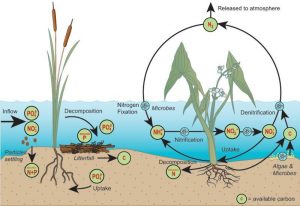
Facebook Twitter Instagram YouTube
Written on: May 15th, 2019 in Education and Outreach
By Alison Rogerson, DNREC’s Wetland Monitoring and Assessment Program
In our Wetland Monitoring and Assessment Program we speak so often about the ecosystem services that wetlands provide or the beneficial functions wetlands perform daily. We rattle them off in varying order “provide vital habitat for plants and wildlife, improve water quality, protect our coasts, act like a sponge to store floodwater, sequester Carbon from the atmosphere”.
We do this so often, that sometimes we forget to take a step back and explain what exactly we mean and how exactly wetlands work. For example, how can a wetland clean water?? Wetlands are muddy and sometimes stinky. How on earth could a wetland clean my water?
Wetlands are magicians. In their own, natural, wonderful form, they magically filter out and pull aside an assortment of nasty stuff that you and I don’t want in our streams, bay and ocean, or as we kayak and fish.
What can wetlands help filter out from our waters, you might ask?
A magician rarely reveals their secrets, but in this case we’re spilling the beans. Wetlands remove nutrients through a combination of complex physical and biological processes. Let’s break it down (pun intended)..
Wetlands are like sponges and are great areas for holding onto water. They are also areas where the speed of water flow is drastically reduced and sometimes even stands still. As the water sits in the wetland, nutrients can be removed from the water in a couple of ways: they can simply sink down and settle on the soil surface, be released into the atmosphere or be trapped in the soil as the water filters its way slowly down through the ground.
As you can see, soils play an important role in this physical process. One of our favorite marsh metaphors to use in presentations is that wetland soils are like a strainer or sieve. We hold up a pasta strainer and kids look at us like we’re crazy but really, it fits. Just like the strainer, wetland soils have lots of tiny holes, nooks and crannies (think English muffin) to trap impurities and toxins. This process allows the cleaner water to continue on through, entering the stream or bay or even our underground aquifers.

There are also biological processes occurring in wetlands that can help to clean our waters. Plants, algae, and bacteria can use and transform nutrients that have sunk onto and in the soil to grow big and strong and create future generations.
Bacteria (or microbes) are really neat organisms that do some fancy biogeochemical processes called nutrient transformations. Ammonification, nitrification and denitrification are examples of nutrient transformations that turn not-so-great chemicals into less harmful ones or into a useful nutrient for plants. All of these processes are facilitated in many places throughout a wetland.
Healthy microbes also need a good source of carbon for their growth and energy and wetland plants serve as a key source of carbon! So the take home message is that these bacteria rely on wetland plants, and a wetland planted with lots of native plants (as opposed to an open pond) is going to be capable of the most nutrient transformation.
If you’re thinking that this is interesting but doesn’t affect me, you might be surprised to learn that approximately 25% of the State of Delaware is made up of wetlands, and that from where you are reading this right now, there is probably a wetland within a mile of you. This means that a wetland is hard at work for you right now trying to keep up with all the demands we place on them.
There are a few things you can do to lighten their load, so to speak.
Let the magician put on a show uninterrupted and we can all enjoy cleaner, healthier waters!